GLOSSARY | SECTION 5 |
|
|
NIC
A Network Interface Card converts computer data to serial data in a packet format that it sends over the LAN. A NIC is installed in an expansion slot or can be
P
Packet
The unit of data that is routed between the sender and destination on the Internet or other
PCMCIA
The Personal Computer Memory Card International Association sets international standards for connecting peripherals to portable computers. Laptop computers typically have a PCMCIA slot that can hold one or two PC Cards to provide features such as Ethernet or wireless connectivity.
PING
A network utility that tests host reachability by sending a small packet to the host and waiting for a reply. If you PING a computer IP address and receive a reply, you know the computer is reachable over the network. It also stands for “Packet Internet Groper.”
Port Triggering
A mechanism that allows incoming communication with specified applications.
PPP
PPPoE
Internet Service Providers for broadband connection.
PPTP
Private IP Address
An IP address assigned to a computer on the LAN by the DHCP server for a specified lease time. Private IP addresses are invisible to devices on the Internet. See also Public IP Address.
SECTION 5, GLOSSARY |
